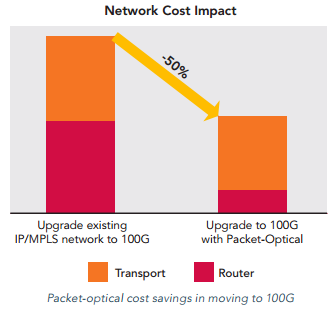Virtualization is nothing without infrastructure: A pragmatic approach to R&E network evolution
There’s no arguing that SDN and NFV are here to stay. The network shift they’ve brought along is evolutionary; however, while SDN orchestrates and optimizes the network resources, the increasing demand for capacity will continue to drive the need to build open, intelligent, physical infrastructure that can meet growing bandwidth demands. That’s right. Physical infrastructure.
Many verticals are experiencing unprecedented bandwidth growth. Looking more closely at this growing demand, we quickly see that user traffic patterns have changed dramatically thanks to the growing utilization of cloud-based applications, storage, and collaboration tools. In Research and Education (R&E) specifically, much of the network operator traffic is made up of students using streaming applications, as well as research file exchanges and collaboration across the globe.
A decade or so ago, routing every packet was critical because the vast majority of traffic was destined for an unpredictable variety of destinations. Traffic today is often primarily from a user uploading or downloading data center content, or from traffic between data centers. Yet, many networks operators still apply yesterday’s network architecture approach to grow capacity. This traditional approach, which requires a router to inspect every packet, no longer provides efficiency from a network cost or bandwidth utilization perspective, and often leads to over-designed and costly networks.
What if you could increase your network capacity for less than you think, leaving more of your budget open for other innovative initiatives?
Offloading routers—and costs
Have you considered upgrading your network to better align with traffic flows? If you insert lower cost-per-bit packet-optical devices to manage the growing transit and protect traffic, you can minimize upgrades on existing routers to only those routers that need additional drop capacity. This then delays further high performance router port purchases and reduces the associated costs—increased capacity for less!
 While solution scenarios vary, customer experience has shown that utilizing a packet-optical solution to offload transit and protect traffic can reduce router traffic by upwards of 75 percent—extending the life of existing routers and enabling the migration to a 100G network with upwards of 50 percent capital savings, compared to the cost of upgrading existing router-based architecture.
While solution scenarios vary, customer experience has shown that utilizing a packet-optical solution to offload transit and protect traffic can reduce router traffic by upwards of 75 percent—extending the life of existing routers and enabling the migration to a 100G network with upwards of 50 percent capital savings, compared to the cost of upgrading existing router-based architecture.
Additionally, reducing the management of router activity and moving the majority of transit traffic to Layer 2 converged packet-optical switches significantly simplifies the design, provisioning, and management of the overall network. Formal OPEX studies are hard to come by, but it’s clear that installation and commissioning tasks for new services are key components of such costs.
Don’t ignore your inner pragmatist
While SDN and NFV are the very near future, don’t ignore your inner pragmatist: the network infrastructure is still critical to providing capacity and performance. However, as the way we use the network evolves, so must the way we think about how we architect this critical infrastructure’s foundation.
Now is the time to better align the traditional approach of yesterday with the dynamic traffic flow and budget realities of today. Ciena can help—connect with a network specialist today and see where your network will take you!





